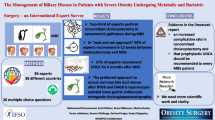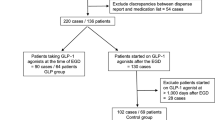Abstract
Introduction
An unbuffered postprandial proximal gastric acid pocket (PPGAP) has been noticed in normal individuals and patients with gastroesophageal reflux disease (GERD). The role of gastric anatomy in the physiology of the PPGAP remains unclear. It is also unclear whether operations that control GERD, such as Roux-en-Y gastric bypass (RYGB) and Nissen fundoplication, change the PPGAP.
Aims
This study aims to analyze the presence of PPGAP in patients submitted to RYGB.
Methods
Fifteen patients who had a RYGB for morbid obesity (mean age 53 years, 14 females, mean time from operation 3 years) were studied. All patients were free of foregut symptoms. Patients underwent a high-resolution manometry to identify the location of the lower border of the lower esophageal sphincter (LBLES). A station pull-through pH monitoring was performed from 5 cm below the LBLES to the LBLES in increments of 1 cm in a fasting state and 10 min after a standardized fatty meal (40 g of chocolate, 50% fat).
Results
Acidity was not detected in the stomach of four patients before meal. After meal, PPGAP was not found in eight patients. In three patients, a PPGAP was noted with an extension of 1 to 3 cm.
Conclusion
PPGAP is present in a minority of patients after RYGB; this finding may explain part of the GERD control after RYGB and that the gastric fundus may play a role in the genesis of the PPGAP.

Similar content being viewed by others
References
Fletcher J, Wirz A, Young J, Vallance R, McColl KE. Unbuffered highly acidic gastric juice exists at the gastroesophageal junction after a meal. Gastroenterology. 2001;121(4):775-83.
Hila A, Bouali H, Xue S, Knuff D, Castell DO. Postprandial stomach contents have multiple acid layers. J Clin Gastroenterol. 2006;40(7):612-7.
Clarke AT, Wirz AA, Manning JJ, Ballantyne SA, Alcorn DJ, McColl KE. Severe reflux disease is associated with an enlarged unbuffered proximal gastric acid pocket. Gut. 2008;57(3):292-7.
Simonian HP, Vo L, Doma S, Fisher RS, Parkman HP. Regional postprandial differences in pH within the stomach and gastroesophageal junction. Dig Dis Sci. 2005;50(12):2276-85.
Vo L, Simonian HP, Doma S, Fisher RS, Parkman HP. The effect of rabeprazole on regional gastric acidity and the postprandial cardia/gastro-oesophageal junction acid layer in normal subjects: a randomized, double-blind, placebo-controlled study. Aliment Pharmacol Ther. 2005;21(11):1321-30.
Pandolfino JE, Zhang Q, Ghosh SK, Post J, Kwiatek M, Kahrilas PJ. Acidity surrounding the squamocolumnar junction in GERD patients: “acid pocket” versus “acid film”. Am J Gastroenterol. 2007;102(12):2633-41.
Mason RJ, Oberg S, Bremner CG, Peters JH, Gadenstätter M, Ritter M, DeMeester TR. Postprandial gastroesophageal reflux in normal volunteers and symptomatic patients. J Gastrointest Surg. 1998;2(4):342-9
Barlow AP, Hinder RA, DeMeester TR, et al. Twenty-four-hour gastric luminal pHin normal subjects: influence of probe position, food, posture, and duodenogastric reflux. Am J Gastroenterol. 1994;89:2006–2010.
De Groot NL, Burgerhart JS, Van De Meeberg PC, de Vries DR, Smout AJ, Siersema PD. Systematic review: the effects of conservative and surgical treatment for obesity on gastro-oesophageal reflux disease. Aliment Pharmacol Ther. 2009;30(11-12):1091-102.
Merrouche M, Sabaté JM, Jouet P, Harnois F, Scaringi S, Coffin B, Msika S. Gastro-esophageal reflux and esophageal motility disorders in morbidly obese patients before and after bariatric surgery. Obes Surg. 2007;17(7):894-900.
Ortega J, Escudero MD, Mora F, Sala C, Flor B, Martinez-Valls J, Sanchiz V, Martinez-Alzamora N, Benages A, Lledo S. Outcome of esophageal function and 24-hour esophageal pH monitoring after vertical banded gastroplasty and Roux-en-Y gastric bypass. Obes Surg. 2004;14(8):1086-94.
Hedberg J, Hedenström H, Nilsson S, Sundbom M, Gustavsson S. Role of gastric acid in stomal ulcer after gastric bypass. Obes Surg. 2005;15(10):1375-8
Author information
Authors and Affiliations
Corresponding author
Additional information
Grant support
The study was supported by the Fundação de Amparo à Pesquisa do Estado de São Paulo (FAPESP) grant # 2007/07940-8.
Meeting presentation
Poster presentation, Digestive Disease Week (DDW), May 1–5, 2010, New Orleans, USA
Rights and permissions
About this article
Cite this article
Herbella, F.A.M., Vicentine, F.P.P., Del Grande, J.C. et al. Postprandial Proximal Gastric Acid Pocket in Patients after Roux-En-Y Gastric Bypass. J Gastrointest Surg 14, 1742–1745 (2010). https://doi.org/10.1007/s11605-010-1309-5
Received:
Accepted:
Published:
Issue Date:
DOI: https://doi.org/10.1007/s11605-010-1309-5




